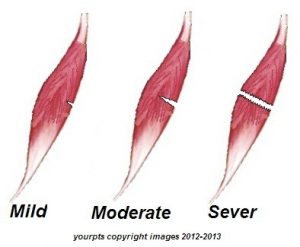Article by Kate McLeod, July 2014
Acute muscle injuries or strains and tears are one of the most common injuries seen in sport.
 The muscles most vulnerable to injury are those crossing two joints, such as the hamstrings, quadriceps or calf muscles. The mechanism of injury usually involves a sudden acceleration or deceleration force during which the muscle fibers fail to cope with load demands of the task.
The muscles most vulnerable to injury are those crossing two joints, such as the hamstrings, quadriceps or calf muscles. The mechanism of injury usually involves a sudden acceleration or deceleration force during which the muscle fibers fail to cope with load demands of the task.
Inadequate warm up, decreased joint range, muscle tightness, fatigue, previous injury, muscle imbalance, technique and spinal problems can all predispose the muscle to injury.
Muscle injuries are classified into 3 grades. These grades help to direct the rehabilitation program and predict the healing time of the injury.
GRADING OF ACUTE MUSCLE INJURIES
Gr I stain (MILD):
Involves a small number of muscle fibers, causes localised pain, but no loss of strength.
Gr II strain (MODERATE):
Involves a significant number of fibres with associated pain and swelling. Pain is reproduced on muscle contraction. Strength is reduced and movement is limited by pain.
Gr III strain (SEVERE):
A complete tear of the muscle. It is most commonly seen at the musculo-tendinous junction (where the muscle attaches to the tendon).
Muscles heal through 3 phases
1. The Inflammatory Phase
During the initial phase of an acute muscle injury, pain, bleeding and swelling are at their worst. Your body’s aims at this stage is to protect the area from further injury and to prepare the injury site for repair. This 48-72 hour period requires ice, compression and a short period of rest to allow the body to start the process of repairing the damaged muscle fibres. No massage should be performed on the affected muscle for the first 24-48 hours. It is recommended that ice is used during this phase rather than anti-inflammatories. Paracetamol can be used to manage pain.
2. The reparative Phase
During this stage, the body starts to lay down new tissue into the area of damage, including regeneration of new muscle fibers and production of connective scar tissue. Early gentle stretch and loading to the damaged area are important in this phase to help model the repairing tissue. All movement in this phase should be within pain limits and massage should be gentle and respectful of the severity of the injury.
3. The Remodeling Phase
During the final stage of the repair process pain decreases and strength and function increases. As you return to regular activity and start to increase load to the damaged muscle, the body may detect that the tissue at the injury site is still weaker than necessary. In response to loading, the body will lay down new tissue and reorganise scar and other tissue in order to help strengthen and support the healing tissue. A rehab program can be provided by your physiotherapist, involving a progressive increase in stretch and load to the muscle as well as a graded return to training program will ensure that the muscle is able to cope with the load demands of the sport and prevent re-injury. The re-modelling phase occurs between 6 weeks and 3 months post injury.
